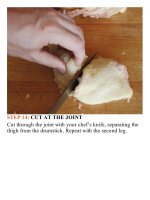The food lab better home cooking through science ( PDFDrive ) 153
Bạn đang xem bản rút gọn của tài liệu. Xem và tải ngay bản đầy đủ của tài liệu tại đây (101.78 KB, 2 trang )
Potatocellscontaintheirownstarch,sothisreallybecomes
aquestionofhowtocutthepotatoesinordertoreleasejust
therightamount.Youcangratethemonaboxgraterorin
the food processor, but if you do, you’ll end up rupturing
potatocells,releasingatonofliquidandstarchfrominside
them. Then you’re forced to squeeze the shreds dry, and
your rösti will come out starchy and sticky, even with
relativelylow-starchpotatoeslikeYukonGolds.
Muchbetter,thoughslightlymoredifficult,istocutthem
on a mandoline. If you have one with extra teeth or blades
(which you should!), it’ll cut the potatoes directly into ⅟₁₆inch shreds for you. If you don’t, it’s easy enough to slice
thepotatoesintothinplanksandthenuseaknifetogetthe
matchsticks you need. A sharp mandoline (and a sharp
knife) = fewer ruptured cells = less sticky starch release =
better texture and more potato flavor in each bite. Some
sources recommend rinsing the cut potatoes to rid them
completely of their starch, then adding a measured amount
ofpurepotatostarchtothembeforecooking,butIfindthe
resultsunsatisfactory.Rinsedpotatoesdon’tsoftenproperly
whencooked,andyouendupwithröstiwithaldentebitsof
crunchypotatoinside.
The other key to great rösti is to parcook the potatoes
beforefryingthem.Why?Well,anybodywho’sworkedthe
Frenchfrystationatarestaurantknowsthatpotatoesbegin
to oxidize as soon as you cut them. Over the course of
fifteen minutes or so, a cut potato will go from being pale
whitetoreddishbrown,andeventuallytoblack.Youdon’t
want your potatoes to be black. Storing sliced potatoes in
water will prevent this from happening (or at least slow it
down),butitalsorinsesawaylotsofstarch.Toolittlestarch
isjustasbadastoomuchstarchinrösti,soIavoidrinsing
or submerging my taters in water at any point. Parcooking
thepotatoesaccomplishesthegoalofpreventingthemfrom
browning and also leads to a better texture in the finished
product—you don’t have to worry about raw potato in the
center of the potato cake. This is one case where the
microwaveisactuallythebesttoolforthejob.Itallowsyou
to cook the potatoes rapidly without either adding moisture
orlosinganexcessiveamount.
For a gussied-up version, I sauté onions and mushrooms
until a deep golden brown and flavor them with a bit of
thymetoformacentrallayerinmypotatocake.Youcould
usewhateversautéedvegetablesyouwant.
After you’ve got your stuffing (if any), cooking the rösti
is a simple matter of moderate heat and a good thick pan
that will cook it gently and evenly. I use a well-seasoned
cast-iron pan, but you can use a good nonstick pan if you
don’t have a cast-iron one. Crisping the potatoes properly
takesawhile,whichgivesyouplentyoftimetobrewyour
coffeeorsqueezeyourmangoes,orpreparewhateverelseit
isyourspouselikesservedwiththeirbrunch.









